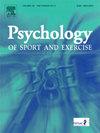Teammate communication, loneliness, and contagion of athlete burnout
IF 3.1
2区 心理学
Q2 HOSPITALITY, LEISURE, SPORT & TOURISM
引用次数: 0
Abstract
Communication among teammates can influence sport experiences of athletes, including burnout. This might occur through sharing of burnout perceptions, fostering development of burnout perceptions in teammates (i.e., contagion). Contagion of burnout may depend on communication frequency with teammates as well as intrapersonal social constructs like loneliness, which can impact attentiveness to or interpretation of communication from others. Our study purpose was to (a) examine if exposure to teammate burnout predicted athlete burnout later in the season and (b) examine if loneliness moderated this relationship. Twice across their season, adolescent softball and baseball athletes (N = 176; 15 teams) completed two network questions about the frequency of speaking with teammates and closest friends on the team, respectively, and established measures of loneliness and burnout. Hierarchical linear regression models were estimated, one for each network question, for global burnout and burnout dimensions. Initial burnout perceptions (βs = .58-.72, ps < 0.001) predicted burnout perceptions at time two. Loneliness (βs = .15-.20 p ≤ 0.05) predicted global, exhaustion, and reduced accomplishment burnout perceptions at time two. Exposure to teammates' global burnout (β = .12, p ≤ 0.05) predicted global burnout perceptions at time two. Exposure to closest friends' burnout did not predict burnout at time two and loneliness did not moderate exposure—burnout relationships. Results offered some support for burnout contagion among adolescent athletes through spoken communication with teammates at practice. Future work should examine communication content to assess if and how particular messages from teammates contribute to athlete burnout perceptions.
队友沟通、孤独和运动员倦怠的传染。
队友之间的沟通会影响运动员的运动体验,包括倦怠。这可以通过分享倦怠感,促进队友倦怠感的发展(即传染)来实现。倦怠的传染可能取决于与队友的沟通频率,以及孤独感等个人社会结构,这可能会影响对他人沟通的注意力或解释。我们的研究目的是(a)检查是否暴露于队友倦怠预测运动员在赛季后期的倦怠和(b)检查孤独是否调节这种关系。青少年垒球和棒球运动员(N = 176;15个团队)分别完成了两个关于与团队中的队友和最亲密的朋友交谈频率的网络问题,并建立了孤独和倦怠的测量方法。估计了层次线性回归模型,每个网络问题一个,用于全局倦怠和倦怠维度。最初的倦怠感(βs = 0.58)。72, ps < 0.001)预测时间2的倦怠感。孤独(βs = .15-)20 p< 0.05)预测了时间2的全球、疲惫和成就感倦怠感的降低。暴露于队友的整体倦怠(β = 0.12, p< 0.05)预测时间2的整体倦怠感知。接触最亲密的朋友的职业倦怠并不能预测时间2的职业倦怠,孤独也不能调节接触-职业倦怠关系。研究结果为青少年运动员在训练中通过与队友的口头交流进行倦怠传染提供了一定的支持。未来的工作应该检查沟通内容,以评估来自队友的特定信息是否以及如何影响运动员的倦怠感。
本文章由计算机程序翻译,如有差异,请以英文原文为准。
求助全文
约1分钟内获得全文
求助全文
来源期刊
CiteScore
6.40
自引率
5.90%
发文量
172
审稿时长
69 days
期刊介绍:
Psychology of Sport and Exercise is an international forum for scholarly reports in the psychology of sport and exercise, broadly defined. The journal is open to the use of diverse methodological approaches. Manuscripts that will be considered for publication will present results from high quality empirical research, systematic reviews, meta-analyses, commentaries concerning already published PSE papers or topics of general interest for PSE readers, protocol papers for trials, and reports of professional practice (which will need to demonstrate academic rigour and go beyond mere description). The CONSORT guidelines consort-statement need to be followed for protocol papers for trials; authors should present a flow diagramme and attach with their cover letter the CONSORT checklist. For meta-analysis, the PRISMA prisma-statement guidelines should be followed; authors should present a flow diagramme and attach with their cover letter the PRISMA checklist. For systematic reviews it is recommended that the PRISMA guidelines are followed, although it is not compulsory. Authors interested in submitting replications of published studies need to contact the Editors-in-Chief before they start their replication. We are not interested in manuscripts that aim to test the psychometric properties of an existing scale from English to another language, unless new validation methods are used which address previously unanswered research questions.

 求助内容:
求助内容: 应助结果提醒方式:
应助结果提醒方式:


